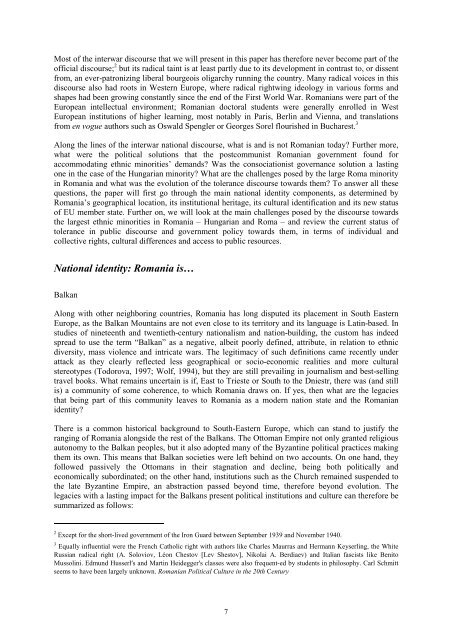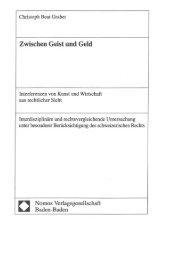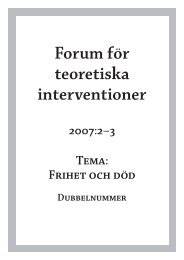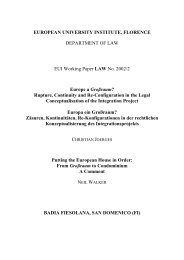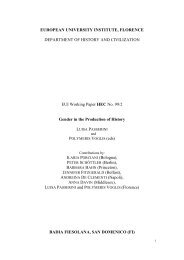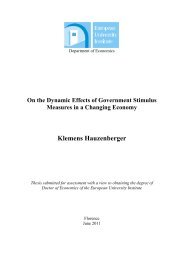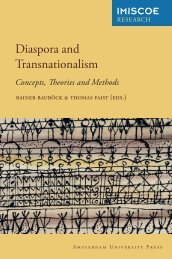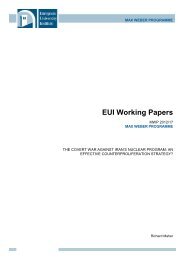Sinziana-Elena Poiana Ioana Lupea Irina-Madalina Doroftei Alina ...
Sinziana-Elena Poiana Ioana Lupea Irina-Madalina Doroftei Alina ...
Sinziana-Elena Poiana Ioana Lupea Irina-Madalina Doroftei Alina ...
You also want an ePaper? Increase the reach of your titles
YUMPU automatically turns print PDFs into web optimized ePapers that Google loves.
Most of the interwar discourse that we will present in this paper has therefore never become part of the<br />
official discourse; 2 but its radical taint is at least partly due to its development in contrast to, or dissent<br />
from, an ever-patronizing liberal bourgeois oligarchy running the country. Many radical voices in this<br />
discourse also had roots in Western Europe, where radical rightwing ideology in various forms and<br />
shapes had been growing constantly since the end of the First World War. Romanians were part of the<br />
European intellectual environment; Romanian doctoral students were generally enrolled in West<br />
European institutions of higher learning, most notably in Paris, Berlin and Vienna, and translations<br />
from en vogue authors such as Oswald Spengler or Georges Sorel flourished in Bucharest. 3<br />
Along the lines of the interwar national discourse, what is and is not Romanian today? Further more,<br />
what were the political solutions that the postcommunist Romanian government found for<br />
accommodating ethnic minorities’ demands? Was the consociationist governance solution a lasting<br />
one in the case of the Hungarian minority? What are the challenges posed by the large Roma minority<br />
in Romania and what was the evolution of the tolerance discourse towards them? To answer all these<br />
questions, the paper will first go through the main national identity components, as determined by<br />
Romania’s geographical location, its institutional heritage, its cultural identification and its new status<br />
of EU member state. Further on, we will look at the main challenges posed by the discourse towards<br />
the largest ethnic minorities in Romania – Hungarian and Roma – and review the current status of<br />
tolerance in public discourse and government policy towards them, in terms of individual and<br />
collective rights, cultural differences and access to public resources.<br />
National identity: Romania is…<br />
Balkan<br />
Along with other neighboring countries, Romania has long disputed its placement in South Eastern<br />
Europe, as the Balkan Mountains are not even close to its territory and its language is Latin-based. In<br />
studies of nineteenth and twentieth-century nationalism and nation-building, the custom has indeed<br />
spread to use the term “Balkan” as a negative, albeit poorly defined, attribute, in relation to ethnic<br />
diversity, mass violence and intricate wars. The legitimacy of such definitions came recently under<br />
attack as they clearly reflected less geographical or socio-economic realities and more cultural<br />
stereotypes (Todorova, 1997; Wolf, 1994), but they are still prevailing in journalism and best-selling<br />
travel books. What remains uncertain is if, East to Trieste or South to the Dniestr, there was (and still<br />
is) a community of some coherence, to which Romania draws on. If yes, then what are the legacies<br />
that being part of this community leaves to Romania as a modern nation state and the Romanian<br />
identity?<br />
There is a common historical background to South-Eastern Europe, which can stand to justify the<br />
ranging of Romania alongside the rest of the Balkans. The Ottoman Empire not only granted religious<br />
autonomy to the Balkan peoples, but it also adopted many of the Byzantine political practices making<br />
them its own. This means that Balkan societies were left behind on two accounts. On one hand, they<br />
followed passively the Ottomans in their stagnation and decline, being both politically and<br />
economically subordinated; on the other hand, institutions such as the Church remained suspended to<br />
the late Byzantine Empire, an abstraction passed beyond time, therefore beyond evolution. The<br />
legacies with a lasting impact for the Balkans present political institutions and culture can therefore be<br />
summarized as follows:<br />
2 Except for the short-lived government of the Iron Guard between September 1939 and November 1940.<br />
3 Equally influential were the French Catholic right with authors like Charles Maurras and Hermann Keyserling, the White<br />
Russian radical right (A. Soloviov, Léon Chestov [Lev Shestov], Nikolai A. Berdiaev) and Italian fascists like Benito<br />
Mussolini. Edmund Husserlʹs and Martin Heideggerʹs classes were also frequent-ed by students in philosophy. Carl Schmitt<br />
seems to have been largely unknown. Romanian Political Culture in the 20th Century<br />
7


